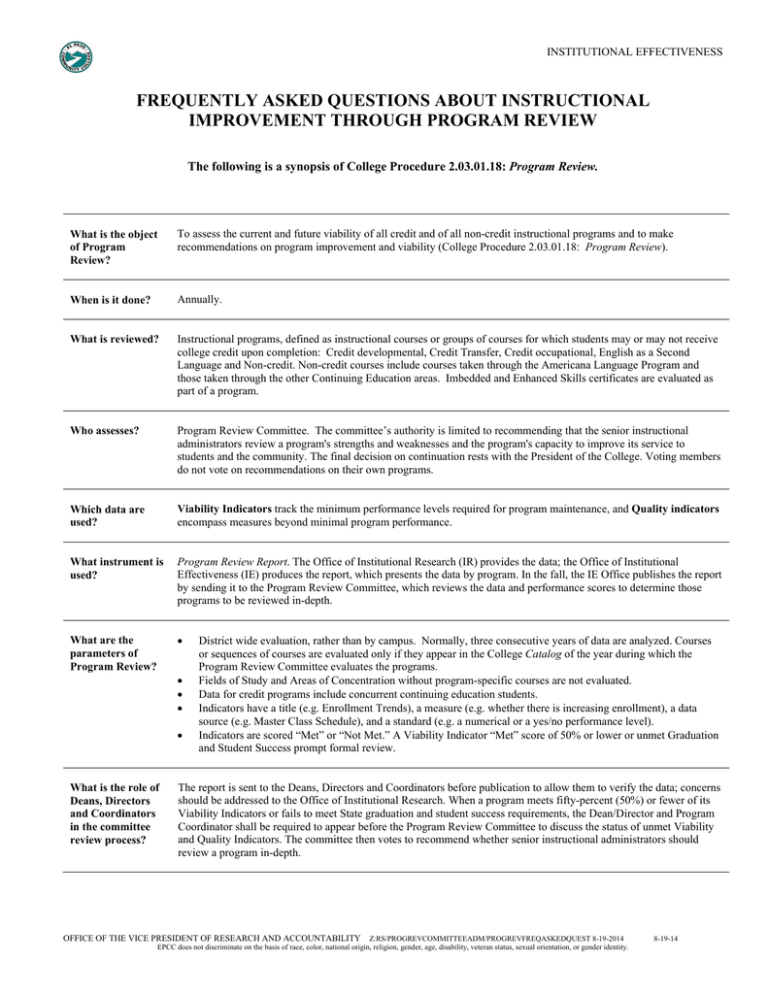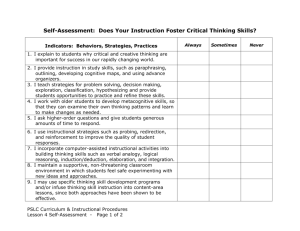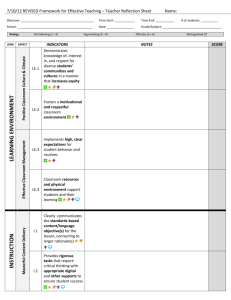FREQUENTLY ASKED QUESTIONS ABOUT INSTRUCTIONAL IMPROVEMENT THROUGH PROGRAM REVIEW Program Review.
advertisement

INSTITUTIONAL EFFECTIVENESS FREQUENTLY ASKED QUESTIONS ABOUT INSTRUCTIONAL IMPROVEMENT THROUGH PROGRAM REVIEW The following is a synopsis of College Procedure 2.03.01.18: Program Review. What is the object of Program Review? To assess the current and future viability of all credit and of all non-credit instructional programs and to make recommendations on program improvement and viability (College Procedure 2.03.01.18: Program Review). When is it done? Annually. What is reviewed? Instructional programs, defined as instructional courses or groups of courses for which students may or may not receive college credit upon completion: Credit developmental, Credit Transfer, Credit occupational, English as a Second Language and Non-credit. Non-credit courses include courses taken through the Americana Language Program and those taken through the other Continuing Education areas. Imbedded and Enhanced Skills certificates are evaluated as part of a program. Who assesses? Program Review Committee. The committee’s authority is limited to recommending that the senior instructional administrators review a program's strengths and weaknesses and the program's capacity to improve its service to students and the community. The final decision on continuation rests with the President of the College. Voting members do not vote on recommendations on their own programs. Which data are used? Viability Indicators track the minimum performance levels required for program maintenance, and Quality indicators encompass measures beyond minimal program performance. What instrument is used? Program Review Report. The Office of Institutional Research (IR) provides the data; the Office of Institutional Effectiveness (IE) produces the report, which presents the data by program. In the fall, the IE Office publishes the report by sending it to the Program Review Committee, which reviews the data and performance scores to determine those programs to be reviewed in-depth. What are the parameters of Program Review? What is the role of Deans, Directors and Coordinators in the committee review process? District wide evaluation, rather than by campus. Normally, three consecutive years of data are analyzed. Courses or sequences of courses are evaluated only if they appear in the College Catalog of the year during which the Program Review Committee evaluates the programs. Fields of Study and Areas of Concentration without program-specific courses are not evaluated. Data for credit programs include concurrent continuing education students. Indicators have a title (e.g. Enrollment Trends), a measure (e.g. whether there is increasing enrollment), a data source (e.g. Master Class Schedule), and a standard (e.g. a numerical or a yes/no performance level). Indicators are scored “Met” or “Not Met.” A Viability Indicator “Met” score of 50% or lower or unmet Graduation and Student Success prompt formal review. The report is sent to the Deans, Directors and Coordinators before publication to allow them to verify the data; concerns should be addressed to the Office of Institutional Research. When a program meets fifty-percent (50%) or fewer of its Viability Indicators or fails to meet State graduation and student success requirements, the Dean/Director and Program Coordinator shall be required to appear before the Program Review Committee to discuss the status of unmet Viability and Quality Indicators. The committee then votes to recommend whether senior instructional administrators should review a program in-depth. OFFICE OF THE VICE PRESIDENT OF RESEARCH AND ACCOUNTABILITY Z:RS/PROGREVCOMMITTEEADM/PROGREVFREQASKEDQUEST 8-19-2014 EPCC does not discriminate on the basis of race, color, national origin, religion, gender, age, disability, veteran status, sexual orientation, or gender identity. 8-19-14




